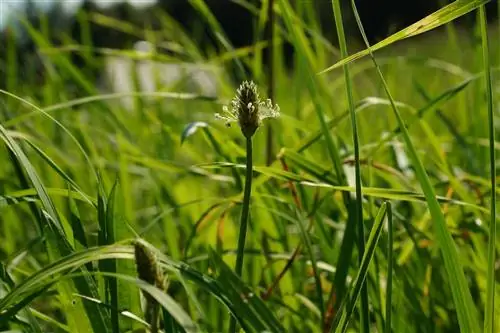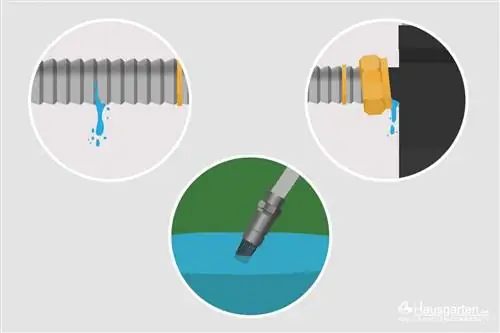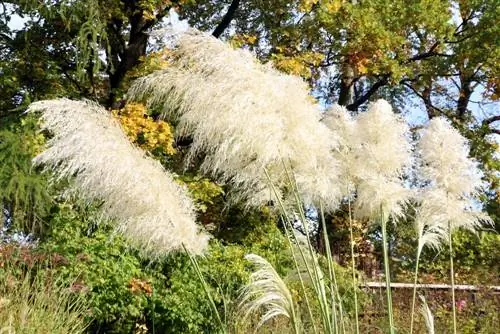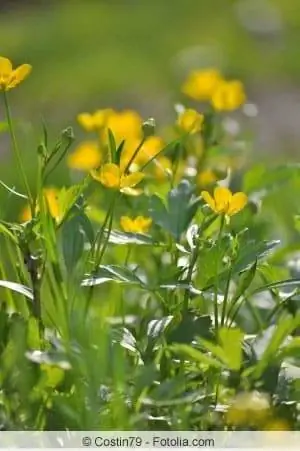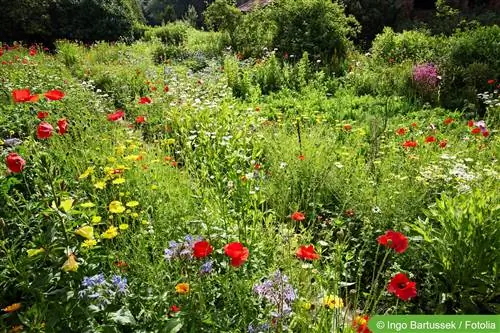- Author admin [email protected].
- Public 2023-12-17 03:39.
- Last modified 2025-01-24 12:45.
Nature lovers and hobby gardeners with little time love the colorful, magnificent natural grass, which offers an optimal habitat for many insects, birds and other small local animals. In addition to the beautiful look, natural grass has another advantage because it does not need to be mowed, otherwise the flowers in the lawn would be destroyed. If you don't need a lawn or play area in your garden, you can create natural grass and enjoy the colorful splendor in the warm seasons.
Getting started
A natural lawn is characterized primarily by the fact that weeds are definitely welcome and are generally not controlled. It is precisely the fight against such weeds that causes a lot of work for the hobby gardener with his English lawn. In a meadow where dandelions, clover, etc. are also allowed, nature lovers can remain quite relaxed. The first steps should be to consider where the natural grass should be laid. Such natural meadows are always best suited for large areas so that the work of mowing can be eliminated. Once the ideal spot has been found, preparations can begin. This can be an existing lawn area, then the further procedure is simple. But even an area in the garden that has not yet been cultivated can be created as natural grass.
Required materials
The required material should be provided in advance for laying natural grass. These are:
- Spade
- Rake
- Sand
- Fertilizer, for example in the form of compost
- Seed mix for wildflowers
- Seed mix for durable lawn
- alternatively use rolled turf
- Water hose
Tip:
If a large area has been selected for natural grass, a rented small excavator can also be used to dig up the ground. This reduces the amount of work required.
Preparation
The condition of the soil is important for further preparation. If it is too moist, gravel must be mixed in as drainage. However, for simple permeability it is sufficient if sand is added to the soil. When choosing a natural lawn, it doesn't matter whether there are large corners or whether there are a lot of bushes on the area. Because the natural meadow shouldn't be mowed anyway, these interruptions to an area don't cause any problems. The ground, if there is no lawn yet, should now be prepared as follows:
- dig with a spade, alternatively with a rented excavator for a large area
- Mix in sand or gravel and fertilizer
- between 15 to 30 kg of sand or gravel are required for one square meter of area
- possibly, if desired, install an irrigation system
- also, if desired, lay electrical cables for garden lighting underground, at least 50 cm deep
- Let the soil rest for about 14 days after processing so that it can settle
Tip:
If an existing lawn area is used to create natural grass, the ground does not need to be prepared accordingly.
Sowing
If the soil has been prepared accordingly, the lawn mixture can be sown. Firmer grasses, such as those used in sports turf, are particularly suitable for natural turf. Wildflower or wild herb mixtures are also added. If you want a flowering meadow all year round, plant bulbs of early-flowering crocuses, tulips or daffodils at small intervals. There are various types of perennials for autumn that bloom into winter and can also be sown or planted in different places. When sowing the lawn, you should pay attention to the following:
- The ideal time for sowing is the time right before or right after summer
- then there will be no burning of the seeds or frost strikes
- If onions should also be planted for early bloomers, they should ideally be planted in autumn
- pay attention to the manufacturer's instructions for meadow flower mixtures, spring is usually the best time
- Distribute seed mixtures for lawns and flowers well
- About 20-40g of lawn seeds are required for one square meter of area
- Wildflowers can be sown as widely as desired
- Work in with a rake and press lightly with a shovel
- Do not leave seeds on the surface, otherwise they will be used as food by birds or ants
- After sowing, water the area well and keep it moist for several weeks
- Do not enter a sown natural grass area until a green, continuous carpet appears
- If an existing lawn is used, just scatter wildflower seeds, plant bulbs and perennials and from this point on don't mow anymore
Tip:
With a natural lawn, the desired meadow flowers only have to be sown and planted when planting. The bulbs of the early bloomers remain in the ground, the perennials used are usually perennial and the wildflowers sow themselves again and again using their own seeds.
Care
The natural grass requires little care because it is, above all, a lawn that does not need to be mowed. There is no need to search for possible weeds in the garden, as these are desirable in natural grass. The natural meadow only needs additional water in a very dry and hot summer. However, watering should only be done in the very early morning or late evening hours so that the grass does not burn. Once a year in spring, you can fertilize with a slow-release fertilizer, such as blue grain, so that the flowers are even more lush.
Tip:
Natural grass is a good alternative, especially for areas that are hardly or not at all used in the garden anyway. Since the lawn does not need to be mowed, relatively large and winding areas are ideal for this.
Conclusion of the editors
Creating a natural lawn is suitable for anyone who wants a lawn that doesn't have to be mowed and doesn't require much care. In a natural meadow, weeds such as dandelions or clover are also desirable. However, when it comes to natural grass, the hobby gardener must be aware that, although this is a very easy-care meadow, it is unfortunately not a useful meadow. If you walk through it too often, the insects are disturbed and the grass can often no longer recover from the many steps because it is very long. Meadow flowers can also be destroyed in such a case. But entering the meadow every now and then to pick a beautiful wildflower bush is definitely allowed.
Worth knowing: How is natural grass created?
The problem with lawns is that many people have the typical English lawn in their minds. This means: There are no weeds at all, there is really only grass on the lawn and it is trimmed accurately. You can literally see the image of the gardener crawling across the lawn on all fours with the nail scissors in his hand and shortening every noticeable stalk by hand to the correct length. However, this has very little to do with natural grass. There is hardly any naturalness left in such an area. Conversely, this means that in order to keep such a lawn alive, an enormous amount of time and money is necessary because nature is not able to maintain such a lawn.
In recent years there has been a move towards presenting well-maintained lawns, but in harmony with nature. The natural grass was created. The natural grass allows other living beings to have a right to exist on it. Of course, the natural grass is also mowed and receives further maintenance measures, but nature is given a helping hand. There is no need for chemical fertilizers or weed killers on natural grass.
- The natural grass is a living surface on which the natural conditions are used.
- Weeds have a chance of growing on natural grass, but their population is monitored and kept in check.
- If weeds get out of hand, they will be pushed back using natural means.
- A natural lawn is characterized by the fact that it is dense and is home to a variety of different plants.
- It therefore has a high recreational value for people and animals and is much more interesting to look at. It also offers a home to wild animals.

